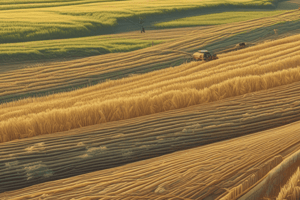Podcast
Questions and Answers
What is the primary purpose of cash crops in agriculture?
What is the primary purpose of cash crops in agriculture?
- To generate profit for farmers. (correct)
- To improve soil quality and health.
- To provide food for local communities.
- To supply fodder for livestock.
Which of the following is NOT a component of Integrated Pest Management (IPM)?
Which of the following is NOT a component of Integrated Pest Management (IPM)?
- Cultural practices
- Exclusive use of chemical pesticides (correct)
- Planting resistant crops
- Biological tactics
What is a key benefit of practicing crop rotation?
What is a key benefit of practicing crop rotation?
- Increases crop yields per season.
- Decreases the soil pH levels.
- Enhances biodiversity in agricultural systems. (correct)
- Eliminates the need for irrigation.
Which nutrient is considered a macronutrient essential for plant growth?
Which nutrient is considered a macronutrient essential for plant growth?
What defines conservation agriculture?
What defines conservation agriculture?
Which technique is best for maintaining consistent soil moisture in crop production?
Which technique is best for maintaining consistent soil moisture in crop production?
What is the primary goal of organic farming?
What is the primary goal of organic farming?
What should be considered when timing the planting of crops?
What should be considered when timing the planting of crops?
Which practice is utilized to reduce spoilage during crop storage?
Which practice is utilized to reduce spoilage during crop storage?
What is the main focus of agroforestry in crop systems?
What is the main focus of agroforestry in crop systems?
Flashcards are hidden until you start studying
Study Notes
Crop Production
- Definition: Cultivation of plants for food, fiber, and other products.
- Types of Crops:
- Food Crops: Fruits, vegetables, grains.
- Cash Crops: Cotton, coffee, tobacco for profit.
- Fodder Crops: For animal feed (e.g., alfalfa).
Crop Management
-
Soil Preparation:
- Tilling to aerate soil and control weeds.
- Testing soil pH and nutrient levels.
-
Planting:
- Timing: Seasonal considerations for optimal growth.
- Spacing: Ensures proper light and air circulation.
-
Irrigation:
- Types: Drip, sprinkler, surface irrigation.
- Importance: Maintains soil moisture levels.
-
Fertilization:
- Macronutrients: Nitrogen (N), Phosphorus (P), Potassium (K).
- Micronutrients: Iron, manganese, zinc, etc.
- Organic (compost) vs. chemical fertilizers.
Pest and Disease Management
-
Integrated Pest Management (IPM):
- Combines biological, cultural, and chemical tactics.
- Monitoring pest populations to make informed decisions.
-
Chemical Control:
- Use of pesticides and herbicides.
- Importance of following safety and application guidelines.
-
Cultural Practices:
- Crop rotation: Reduces pest buildup and improves soil health.
- Intercropping: Planting multiple crops to deter pests.
Harvesting and Post-Harvest Management
-
Harvesting Techniques:
- Manual vs. mechanical harvesting.
- Timing is crucial for maximum yield and quality.
-
Storage:
- Controlled environments to reduce spoilage.
- Importance of drying to prevent mold and decay.
-
Marketing:
- Strategies to reach consumers effectively.
- Understanding market demands and pricing.
Sustainable Practices
-
Organic Farming:
- Avoidance of synthetic chemicals; use natural fertilizers.
- Focus on biodiversity and ecosystem preservation.
-
Conservation Agriculture:
- Minimal soil disturbance, crop rotations, cover crops.
- Aims to protect soil health and increase resilience.
-
Agroforestry:
- Integrating trees and shrubs into crop systems.
- Enhances biodiversity and protects against erosion.
Crop Production
- Cultivating plants for food, fiber and other products
- Types include food, cash, and fodder crops
- Food crops: fruits, vegetables, and grains
- Cash crops: cotton, coffee, tobacco; grown for profit
- Fodder crops: alfalfa and others, used for animal feed
Crop Management
- Soil Preparation:
- Tilling aerates soil and controls weeds
- Soil testing: important to determine pH levels and nutrient content
- Planting:
- Timing: key for optimal plant growth (seasonal considerations are key)
- Spacing: ensures proper light and air circulation for healthy growth
- Irrigation:
- Methods like drip, sprinkler, surface irrigation
- Maintains soil moisture for healthy plants
- Fertilization:
- Macronutrients like Nitrogen, Phosphorus, and Potassium needed for growth
- Micronutrients: Iron, Manganese, Zinc, etc.
- Organic fertilizers (compost) vs. chemical fertilizers
Pest and Disease Management
- Integrated Pest Management (IPM)
- Combines biological, cultural, and chemical methods
- Monitoring pest populations allows for informed decisions
- Chemical Control:
- Involves use of pesticides and herbicides
- Strict adherence to safety and application guidelines is essential
- Cultural Practices:
- Crop rotation: Reduces pest buildup and improves soil health
- Intercropping: planting multiple crops to deter pests
Harvesting and Post-Harvest Management
- Harvesting Techniques:
- Manual vs. mechanical harvesting
- Key factor: timing for maximum yield and quality
- Storage:
- Controlled environments are key to prevent spoilage
- Drying: essential to prevent mold and decay
- Marketing:
- Strategies to reach consumers effectively
- Understanding market demands and pricing is essential
Sustainable Practices
- Organic Farming:
- Avoidance of synthetic chemicals, use of natural fertilizers
- Focus on biodiversity and ecosystem preservation
- Conservation Agriculture:
- Minimal soil disturbance, crop rotation, cover crops
- Protects soil health and improves resilience
- Agroforestry:
- Integrating trees and shrubs into crop systems
- Enhances biodiversity and protects against erosion
Studying That Suits You
Use AI to generate personalized quizzes and flashcards to suit your learning preferences.




